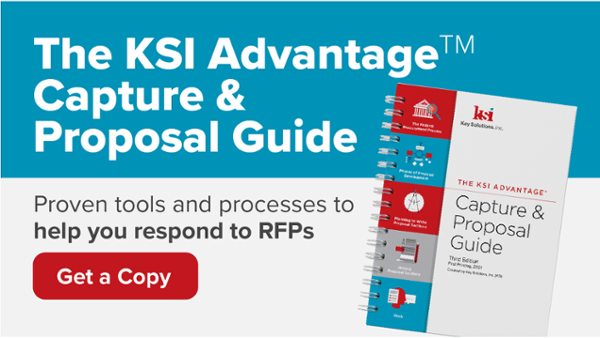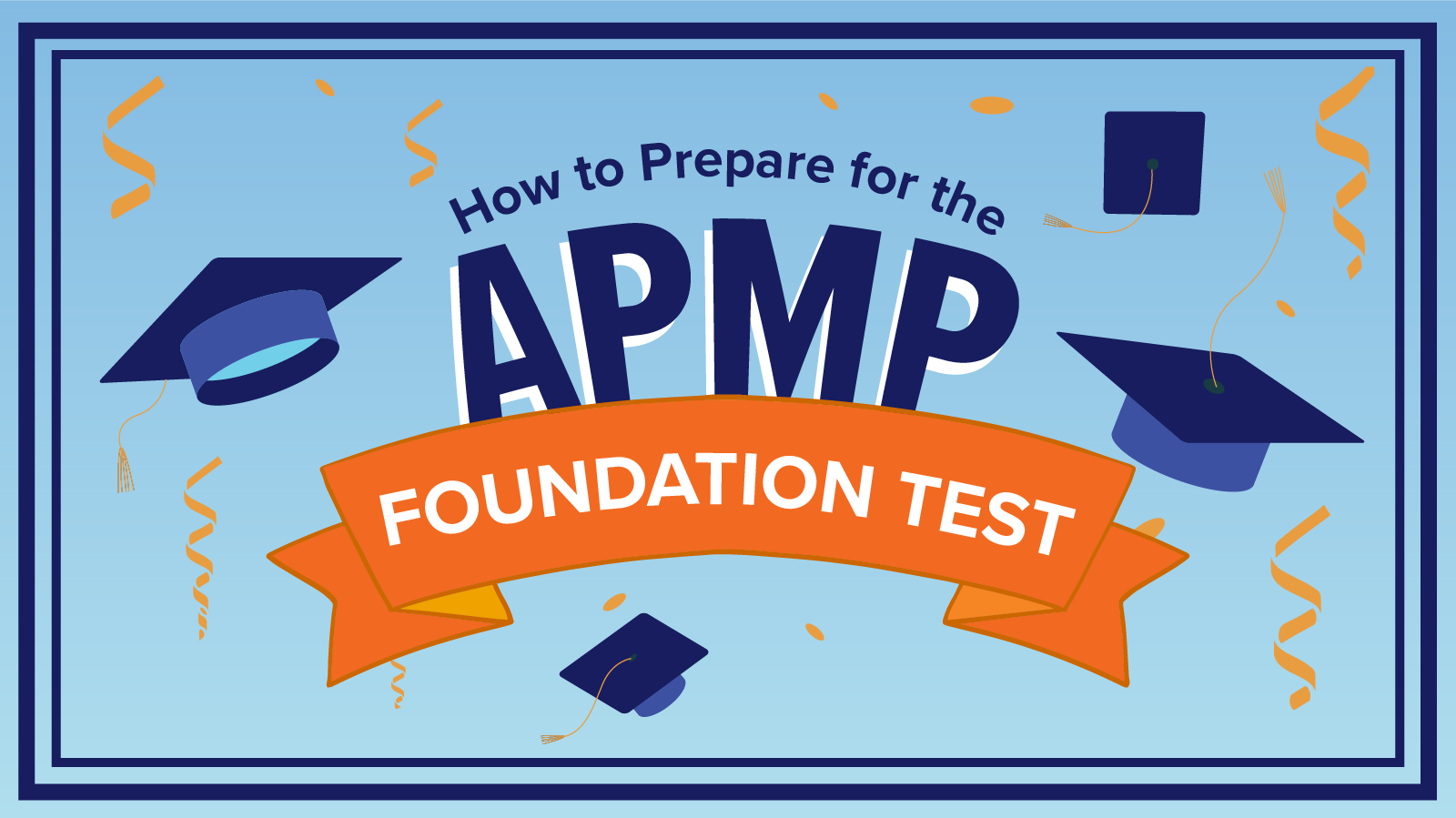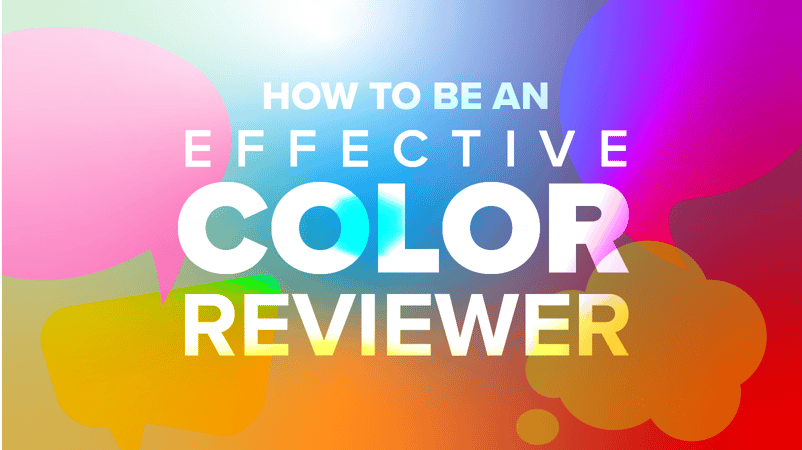
If you work for any company that writes proposals, there is a chance that you already have or will be asked to participate in a color team review.
Frequently, proposal teams will reach out to technical subject matter experts (SMEs) or employees with customer experience to provide impactful proposal feedback based on their individual knowledge set. However, it is common for these individuals to lack experience with the proposal process, so they may not understand the types of feedback that the team would find useful.
This article is meant to be a reference for employees who want to provide valuable color team review feedback but lack prior experience. However, experienced color team reviewers may find these tips helpful as well! We'll be covering the following:
- Color Team Basics
- How to Prepare for a Color Review
- How to Provide Effective Feedback
Color Team Basics
Color teams are broken down into different phases or ‘colors’ (as seen below in Figure 1). For a more in-depth review on each of the color phases themselves, please reference our article, A Guide To Proposal Color Team Reviews & Ratings.
Figure 1. Color Review Flowchart. A typical order of color review stages.
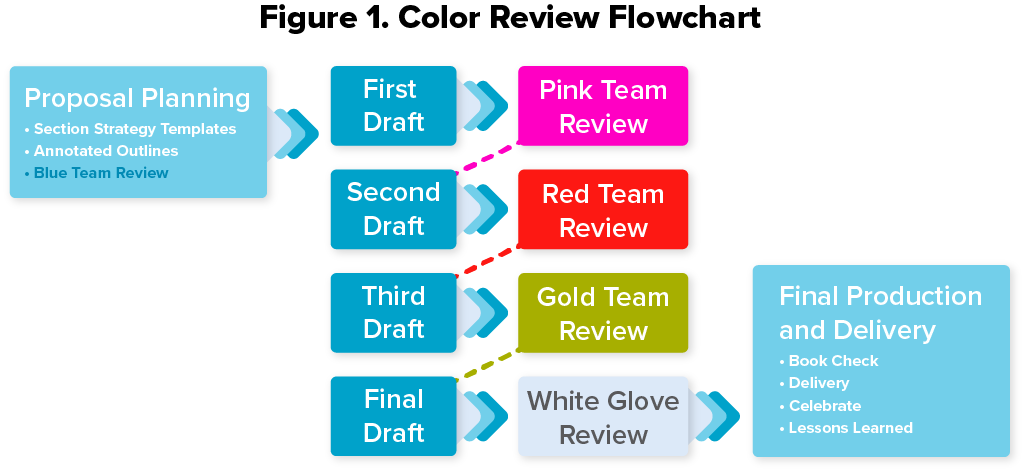
A proposal team will typically try to keep the same group of reviewers for pink and red teams to enable writers and reviewers consistency in their edits. Gold team will be a more limited pool of reviewers, usually consisting of the proposal manager, capture manager, the company division or operations manager, the proposal volume managers, and a contract representative.
Depending on the size of the company and the proposal team, there may be more or fewer people involved. This team’s goal is to review the entire proposal from start to end in order to identify any inconsistencies or errors of any kind and verify that the proposal is compliant.
After each color team review, there will be a recovery phase where the writers take all the feedback and notes from the review team and integrate it back into the document to prepare it for the next phase of the process.
How to Prepare for a Color Review
Because the time set aside for the color review is limited, it is helpful to come to the review prepared. Before the color review, you’ll want to review and understand key documents, including:
1. Solicitation Documents.
It will be difficult to be a valuable color team reviewer if you have no context to base your review on. Requests for Proposals (RFPs) tend to be lengthy and will likely have some information you don’t need as a reviewer. You can prioritize your preparation by focusing on reading Sections C, L, and M, or the Performance Work Statement (PWS)/Statement of Work (SOW), Instructions to Offerors (ITO), and Evaluation Criteria, depending on the format of your proposal.
These sections will contain most of the content you will be expected to review against. Section C/PWS/SOW deals with requirements of the work to be performed, while Sections L/ITO and M/Evaluation Criteria deal with instructions and evaluation criteria. Many solicitations also have Attachments, which may contain required templates and other compliance related documents. If these are included in the solicitation, be sure to review these documents as well.
2. Compliance Matrix and Annotated Outline.
If available to you, read your proposal team’s outline and compliance matrix. These two documents should be prepared by your proposal team early in the writing process and can guide you in reviewing the document’s compliance (if they have been prepared appropriately).
3. Win Themes Document.
Ask for your company's Win Themes for the proposal. These should either be written up in their own document, or potentially found in the proposal kick-off meeting slides or capture plan. Win Themes should be statements that tell the evaluators or your customer why they should choose your team through conveying clear features and benefits. It is possible that your company will have different Win Themes for the overall proposal and each section or volume as well, so ensure you know all of the themes that will be relevant for the section you’re reviewing.
4. Previous Debriefs.
If reviewing for any teams after Pink, read through the slides or documents from the previous review out-brief. This can point out where previous weaknesses or deficiencies might be found to verify if they have been corrected since then.
How to Provide Effective Feedback
It’s important to remember that a good color team review is more than just peer editing.
As a color team reviewer, your focus should always be “how can I best help the writing team?”
To be a helpful and effective color team reviewer, it’s important to know how to provide feedback the right way so that you become an asset to the proposal team. You’ll want to make sure to use an effective tone, provide specific and effective feedback, and target your comments based on the goals of the color review.
Following these guidelines will save the proposal team time and effort in recovering the proposal content to make it more compliant and compelling. During each review, you should put yourself in the position of thinking/acting as an evaluator.
How would you rate the proposal if you were the client deciding on a winning proposal?
Use an Effective Tone
It’s always important to make sure the tone of your review is helpful and to avoid feedback that can be interpreted as too negative. Even if you’re reviewing a weak section, keep in mind that the author has likely put a lot of time and effort into it. Being overly negative can discourage the author and will make it more difficult to recover the section. Instead of criticizing, focus your comments to first highlight overall strengths, then comment on any weaknesses and/or deficiencies.
When you identify any problem areas, make sure to provide clear recommendations for how to correct the issue. It can be helpful to approach every review with the following mindset:
- If so, what exactly is missing, or what makes it incorrect?
- What is at least one actionable suggestion the writer could use to fix it?
- Examples for productive ways to frame feedback tone:
- Harsh Tone: This section is completely non-compliant. You need to rewrite this to address the following requirements: a, b, and c.
- Better Tone: This section doesn’t address the following requirements: a, b, and c. Recommend restructuring the section to add headings to call attention to where we address each of these elements. Consider mapping to the RFP requirements in the new headings.
Provide Constructive and Specific Feedback
The most important part about conducting a review is getting your feedback to the writer in a way that is useful and actionable. You should always strive to make yourself available for follow-up questions for the writers about your comments, but in case they aren’t able to clarify, you need to make them as complete and helpful as possible.
- Bad Comment: “Too vague, fix.”
- Better Comment: “Lacks connection between our solution and customer needs. Try adding more examples.”
- Best Comment: “The customer defines a need for OCONUS analyst support with experience working with their systems. Recommend re-defining our analyst support strengths according to their specific experience with the Government’s systems and better highlight our ability to support OCONUS operations.”
Always re-read your comments and ask yourself, “If I were a writer receiving this comment, how useful would it be to me?”
Target Your Comments Based on the Goals of the Color Review
Proposals are reviewed iteratively so that teams can catch major issues or problems before it is too late to resolve them.
When reviewing the proposal at each phase, it’s important to provide comments appropriate to the expected document maturity (see Figure 2). The following subsections provide guidance for how to tailor your review during Pink, Red, and Gold Team.
Figure 2. Color Team Stages and Goals. Ideal completion percentages and focuses for each color review.
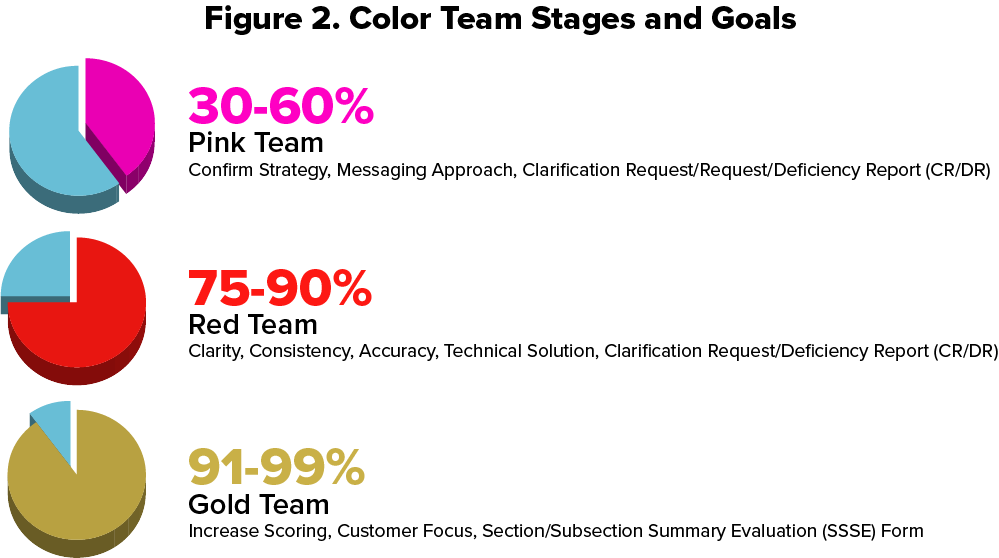
Provide Pink Team Appropriate Comments
During Pink team, keep in mind you will be reviewing a document that may not be complete yet. This is the first review of the proposal draft, and it is intended to make sure that the solution and corresponding proposal content is on the right track. The solution should encompass the customers’ requirements from the SOW or PWS.
The proposal content should be structured according to the instructions (typically section L) while addressing the evaluation criteria (typically section M). The primary objective of the pink team is to ensure the proposal is:
- Compliant, responsive, compelling, and easy to score
- Is there a solution here?
- Does the section being reviewed answer the requirements?
- Can I identify the solution and win themes easily if I were grading this?
- Technically accurate
- Does our solution use the right methods and tools to fit the requirements?
- How does our solution incorporate or account for necessary products?
- Reflective of key selling points, themes, and the proposal strategy
- What makes our solution the best option?
- Why should they pick us over everyone else?
- Can I see that in this document?
- Free of major gaps or problem areas
- Is the document missing anything?
- Are any of the sections completely off base?
While you are reviewing each section, you want to look for areas where there should be Win Themes or Discriminators and ensure they are conveyed in a way that adds value to the document. The solution should be present and evident throughout the document with no gaps in answering requirements. All of the writing should be relevant to the work being proposed and the company's ability.
If you’re reviewing a proposal about how to expand a services contract to perform international operations, and the document never mentions international capabilities, that is an example of a gap that needs to be corrected.
After a review, you will normally be asked to attend a debrief in which you will provide your feedback to the proposal team and the reviewers will be expected to provide a rating for the document or section they reviewed. There are typically five options for rating a section.
- Red. This rating means the document is Unacceptable. It does not meet requirements and contains one or more deficiencies and cannot be awarded.
- Yellow. This rating means the document is Marginal. It does not meet requirements and does not present an adequate approach, or understanding of requirements, or the proposal has too many weaknesses not offset by strengths.
- Green. This rating means the document is Acceptable. It meets requirements and has an adequate approach and understanding of requirements. Strengths and weaknesses offset each other, or they have little to no impact on performance.
- Purple. This rating means the document is Good. It meets requirements and conveys a thorough approach and understanding of requirements. It contains strengths that outweigh any weaknesses.
- Blue. This rating means the document is Outstanding. It meets requirements and indicates an exceptional approach and understanding of requirements. The strengths far outweigh any weaknesses.
When rating the Pink review, you want to rate the document according to both the current state and where it’s headed. If the section is clearly not where it needs to be and needs a lot of work to meet requirements and compliance, then it might deserve a yellow or red rating. If most of the content is viable, compliant, and responsive, but it’s missing parts that are under development or can be addressed by comments during recovery, it is probably closer to a green rating.
In some cases, you will get sections in a Pink Team review that are already fairly comprehensive, compliant, and responsive—which would deserve a blue rating—but that is more common in Red Team reviews after writers have had an opportunity to address initial edits and comments.
Provide Red Team Appropriate Comments
At Red Team, the document has typically already been through one review and recovery phase (Pink Team), so the document should be around 75 – 90% complete, and the document should be judged more critically (but NOT negative still!).
Throughout your review, there should be a solution clearly defined and all themes and discriminators should be evident, easy to grade and tie smoothly into the narrative of the overall proposal.
At this point, you also want to begin judging the proposal on how it all works together instead of just each of its parts individually. Do the headings and sub-headings all follow the compliance matrix and meet section L/M requirements? Is the document organized in a way that makes sense and flows logically through the solution with a high level of readability?
When reviewing for Red Team, you want to focus on the following aspects:
- Compliance: The material in the document responds to the requirements of the RFP
- Compelling: The material should deliver the core message focused on benefits to the customer
- Clarity: The material presented is clear and complete
- Consistency: The document is readable and flows well throughout
- Accuracy: The information in the document is correct
- Strategy: The technical solution and win themes are successfully incorporated
You also want to judge any graphics at this point that have been included in the document. Are they relevant, accurate, and do they make sense?
A good rule of thumb for reviewing graphics is to read them as if you knew nothing else about the content and assess if you could still understand it. Ask yourself whether it conveys the same message it is being used to enhance in that section. Graphics are always meant to be a value add to the overall document. If the graphic doesn’t make sense or isn’t contributing to the narrative the way it should be, then it’s just taking up valuable page space that could potentially be better used to write compelling content.
Also, consider that graphics in proposals are typically not set in stone. If you like the use of a graphic for a section, but just the graphic itself is missing valuable information or needs to be altered or developed, you can make those comments in your review. In Red Team, you should also be paying closer attention to smaller edits throughout, including spelling, grammar, and general readability.
When rating a section at Red Team, you should rate the document according to its current state. If there are still sections missing many requirements or that have compliance issues, it is likely a yellow or possibly even a red. If most of the document clearly answers requirements and meets compliance, the document is likely green. If the document is in tip-top shape and presents a complete, compelling, and compliant proposal, it may even be blue at this stage.
Provide Gold Team Appropriate Comments
Depending on your role in an organization, you may or may not have the opportunity to participate in a Gold Team review.
Frequently, Gold Teams are reserved as a final executive sign-off on the solution to ensure the company is OK with delivering the proposed solution. A Gold Team review should be treated as the final review for the proposal team purposes. It will go through one more review at a high level (White Glove Review) before production, but there should be no revisions needed after Gold Team other than correcting major inaccuracies.
At this point, the document should be complete, compelling, compliant, and easy to read. The story and solution being presented should be evident throughout and flow easily through a narrative. The content should be easy to evaluate against the solicitation and compliance matrix. There should be no spelling and grammar mistakes after Gold, so you should take multiple passes over the document paying close attention to detail for these items, as well as verify compliance and solution viability.
All graphics at this point should be complete and add value to the story. You should ensure that the Table of Contents and any headings or sub-headings are consistent in the document. You should also verify that there is consistency across all volumes and ensure there are no inconsistencies in any naming and terminology used.
If any acronyms are included in the document, verify they have been spelled out the first time they appear and, if required, that they are included in the acronym list or glossary. Compare the document to the RFP to make sure that section numbering, section naming, and any other specific requirements are compliant in the proposal.
Conclusion
When conducting a color team review, it is helpful to have previous review experience to provide good, useful comments.
However, even if you haven’t provided reviews before, remember that the proposal team chose you to review the document for a reason. Your background, customer knowledge, or other expertise are all parts of what makes you an asset to the team, and you should use these strengths, along with the guidance above, to provide useful, meaningful reviews.
You can successfully provide the value that you were recruited to contribute by making useful and actionable comments according to the guidelines above while leveraging your knowledge and expertise.



